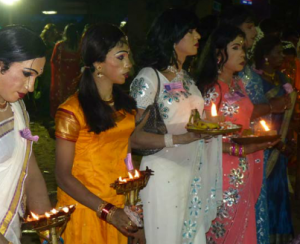 Kollam: Men from across the state and now even outside it look forward to two days on the calendar of the famous Kottankulangara Devi Temple at Chavara near Kollam for a chance to dress as women.
Kollam: Men from across the state and now even outside it look forward to two days on the calendar of the famous Kottankulangara Devi Temple at Chavara near Kollam for a chance to dress as women.
The cross-dressing is part of traditional ritual festivities. The men also carry large lamps. The first of the two-day dressing event drew to a close early on Monday.
Located about 80 km from the capital city, the most important event in the 19-day annual festival in this temple happens over the last two days. Men arrive from various places, and dress up as women to please the local deity, who is reputed to be able to fulfill their wishes once they appear in women’s clothes.
Speaking to IANS, Dileep, a temple official, said that each year the number of men turning up in women’s dresses seems to be increasing.
“Last night, we had more than 6,000 men who came dressed as women and prayed to the Devi (goddess). Tonight we expect even larger numbers,” Dileep said.
The festival is called the “Kottankulangara Chamayavilakku”.
There are many stories about the origin of the festival. The most popular version is that a group of boys, all cowherds, would playfully dress up as girls and offer flowers and a coconut dish called “kottan” to a stone they considered as a goddess.
The story goes that one day the goddess appeared before one of the boys.
Subsequently, a temple came up and the ritual of men dressing up as women to offer prayers to the goddess got under way.
This stone has now come to be regarded as the temple deity, and some say the stone has been growing in size over the years.
The festival attracts people from various faiths.
“Of course, the Devi is very powerful. I’ve come from Andhra Pradesh for the festival for the first time, after friends told me about this unique ritual. I took part, and I know it’s left me feeling really happy,” said one devotee.
The most auspicious time for taking part in the ritual is between 2 a.m. and 5 a.m.. However, there are devotees who wish to get past the huge rush, and arrive much earlier. There are streams of men dressed as women in the typical Kerala saree at the temple, carrying lamps.
“The lamps are available on rent. Those taking part in the ritual have to come with their own dress. There are several counters at the temple premises where the men are dressed up by beauticians,” Dileep said.
The lamp is a peculiarity of this temple, not seen elsewhere. It is mounted on a long wooden rod and rises to the waist.
“I had come here the first time to report the event, but seeing it I too felt like participating. So here I am!” said a journalist who did not wish to be identified.
Source: NDTV
